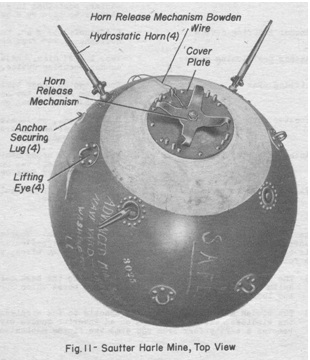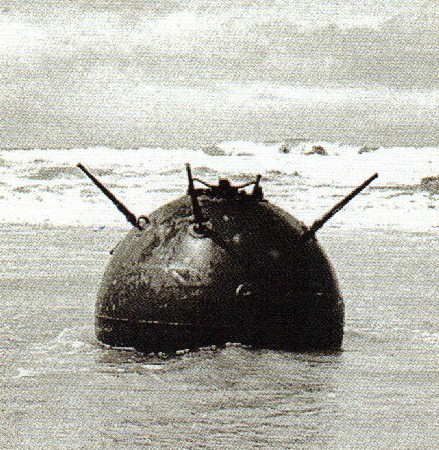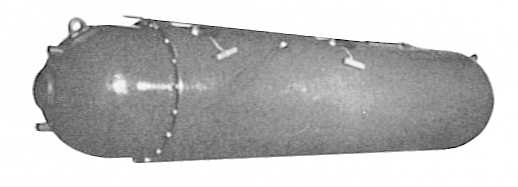French mines are designated by a letter denoting the manufacturer and a sequential model number. Many mines have a suffix which further identifies either the type or the manufacturing process.
| Prefix | Manufacturer | Notes |
|---|---|---|
| B | Bréguet | Relatively small horned mines, although an antenna mine entered service just prior to World War II. |
| H | Sautter-Harlé | Anti-ship types. |
| HS | Sautter-Harlé | Sautter-Harlé for submarines. |
| Prefix | Notes |
|---|---|
| AR | Amorçage Rapide (rapid priming) |
| B | Brown type antenna mine |
| G | Made at Guérigny to Harlé drawings |
| M | Modified |
| P | Profonde (depth of mine increased from 40 m to 90 m) |
| SM | Submarine Mine |
| U | Unifiée (built with standardized components) |
| UM | Mine designed for deeper depths than P types, at least 180 m |
| Y | Hertz Horns |
| Z | Switch Horns |
Post-World War II mines have been developed by Thomson CSF (later Tomson Sintra) and DCN.
Most French mines in service during World War II were switch horned type and all were developed pre-war. The rapid defeat of France early in the war halted any further development activity.
Post-war, France investigated cosmic ray triggers based upon German project work, but no mine using this trigger appears to have entered service use. Mines that have been introduced since the 1950s are influence and acoustic types.
Lever-fired with a 0.77 m (30 in) spherical shell. Total weight of 360 kg (794 lbs.), charge 60 kg (132 lbs.) of gun cotton.
Lever-fired with a 0.865 m (34 in) spherical shell. Entered service in 1916. Total weight of 650 kg (1,433 lbs.), charge 100 kg (220 lbs.) of Mélinite.
Lever-fired with a 0.865 m (34 in) spherical shell. Entered service in 1922. Total weight of 670 kg (1,477 lbs.), charge 110 kg (243 lbs.) of Mélinite.
Six switch horn type with a 0.785 m (31 in) spherical shell. Entered service in 1936. Total weight of 530 kg (1,168 lbs.), charge 80 kg (176 lbs.) of Mélinite. Mooring wire could be 225, 300 or 400 m (738, 984 or 1,310 feet) with the mine at 90 m (295 feet).
Pendulum-fired with a 0.90 m (35 in) spherical shell. Total weight of 520 kg (1,146 lbs.), charge 80 kg (176 lbs.) of gun cotton. Entered service during World War I.
Five switch horn type with a 0.75 m (34 in) spherical shell. Entered service in 1922. Total weight of 670 kg (1,477 lbs.), charge 110 kg (243 lbs.) of Mélinite.
Coast defense mine with five switch horns (four on H4AR) on a 1.04 m (41 in) spherical shell. H4 entered service in 1924, H4AR in 1930. Total weight 1,135 kg (2,502 lbs.), charge 220 kg (485 lbs.) of TNT.
Five switch horn (four on H5AR) type with a 1.04 m (41 in) spherical shell. H5 entered service in 1928, H4AR in 1930. Total weight 1,160 kg (2,557 lbs.), charge 220 kg (485 lbs.) of TNT. Some H5 mines used antennas.
Four switch horn type with a 1.04 m (41 in) spherical shell. Entered service in 1935. Total weight 1,100 kg (2,425 lbs.), charge 220 kg (485 lbs.) of TNT. Used a 500 m (1,640) mooring cable with the mine at 180 m (590 feet).
Experimental mine of 1938 intended for use at great depths. Not in service and details unknown.
Four switch horn type with a 1.15 m (45 in) spherical shell. Total weight unknown, charge 330 kg (661 lbs.) of TNT.
Multiple mine with one primary and four auxiliary bombs. Main mine had six switch horns while the auxiliary mines had four. This was an anti-submarine type with the main mine having a 0.83 m (31 in) spherical shell. Main mine had a weight 665 kg (1,446 lbs.), charge 100 kg (220 lbs.) of TNT. Used a 300 m (984 foot) mooring wire.
Five switch horn type with a 0.77 m (30 in) spherical shell. Total weight of 488 kg (1,076 lbs.), charge 60 kg (132 lbs.) of gun cotton. Entered service during World War I.
Modified version of HS1 and used the same spherical shell. Total weight of 700 kg (1,543 lbs.), charge 113 kg (249 lbs.) of TNT. Entered service in 1920.
Five switch horn type with a 1.04 m (41 in) spherical shell. Entered service in 1920. Total weight of 1,090 kg (2,403 lbs.), charge 220 kg (485 lbs.) of TNT.
These were a series of coast defense mines which all used a 1.04 m (41 in) spherical shell. HS4 entered service in 1928, HS4AR and HS4P in 1930. These mines appear to have been similar to the standard H4 mine series. Total weight 1,150 kg (2,535 lbs.), charge 220 kg (485 lbs.) of TNT. HS4, HS4U and HS4UM used five switch horns while HS4AR and HS4P used four pushrod type.
Slightly smaller than other HS4 types with a 1.00 m (39 in) spherical shell. Total weight 1,150 kg (2,535 lbs.), charge 220 kg (485 lbs.) of TNT.
Four switch horn type with a 1.04 m (41 in) spherical shell. Total weight 1,150 kg (2,535 lbs.), charge 200 kg (441 lbs.) of TNT.
Four switch horn type with a 1.04 m (41 in) spherical shell. Total weight 1,150 kg (2,535 lbs.), charge 200 kg (441 lbs.) of TNT.
Unknown trigger type with a 0.60 m (24 in) spherical shell. Did not enter service. Total weight 575 kg (1,268 lbs.), charge 80 kg (176 lbs.) of TNT. Did not enter service.
A multi-influence type designed for submarine laying. Fuzing is magnetic, acoustic or pressure. Main contractor is DCN with Thomson Sintra supplying the sensors. Dimensions are 52 cm x 300 cm (20.5 x 118 in), total weight 1,000 kg (2,200 lbs.) with a charge of 600 kg (1,323 lbs.) tritonal explosive. Development began in the early 1970s with service deliveries starting in 1988.
Magnetic/acoustic mine designed for submarine laying. Designed to be triggered by any ship displacing over 1,000 tons and can be set to wait up to 30 days before arming. Includes a programmable ship counter. Dimensions 53.3 cm x 252.5 cm (21 x 99.4 in), total weight 850 kg (1,873 lbs.) with a 530 kg (1,168 lbs.) warhead. Developed by Thomson Sintra.
Aircraft mine with parachute retarding with acoustic/magnetic fuzing. Developed by Thomson Sintra. Dimensions are 110 cm tall x 120 cm diameter (43.3 x 47.2 in) with a total weight of 1,500 kg (3,306 lbs.) and a charge of 1,000 kg (2,204 lbs.). Programmable delays similar to TSM 3510.
"Naval Weapons of World War Two" by John Campbell
"S-Boote: German E-boats in action 1939 - 1945" by Jean-Philippe Dallies-Labourdette
"The Naval Institute Guide to World Naval Weapon Systems 1991/92" by Norman Friedman
---
Special help by Gary Cartwright
21 April 2006 - Benchmark
24 February 2013 - Added pictures of H5AR mines
17 February 2018 - Converted to HTML 5 format




